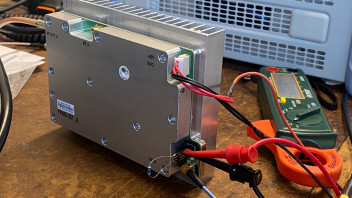It was the Thanksgiving holiday here in the US, so I had time again to work on this stuff.
Today I tested my “EBay amplifier”.

Very low cost, and has a nice and solid machined aluminum housing, but no heatsink.
So my first step was to find suitable heatsink stock and drill the mounting holes.
I don’t have metal machining tools, just hand saws and drills etc. so the heatsink machining is not pretty but it works.

The amp works fine, and puts out good power.
With 26 volt VDD, I measured 30 W out at -8dBm in.
The amplifier is not tuned for 2.4 GHz. It’s best at 2.25 GHz, where it has 3.5dB more gain.
But it’s fine, this is already more than I’ll need, so I'm not going mess the with the matching.
(The amp also has an internal isolator that is not designed for 2.4 GHz, it would be easy to remove the isolator and get more gain, but there’s no need)

